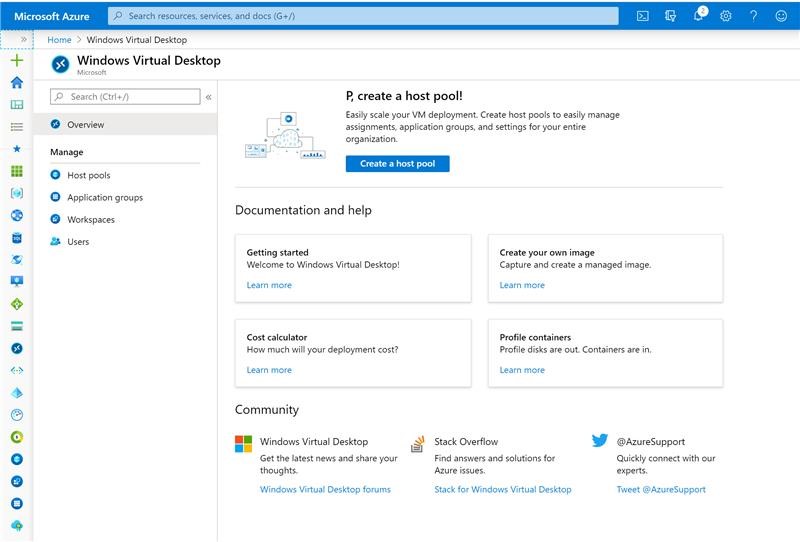Enable remote work faster with new Windows Virtual Desktop capabilities
The world has changed dramatically in the past few months. Due to the global health crisis, many people are working remotely for the first time. Organizations of all sizes have had to quickly shift focus and support users who need to stay connected from new locations and devices. In many cases, that means quickly giving users remote access to their corporate desktops and important applications, so that they can be productive immediately and you’re not waiting to acquire new hardware or to redirect internal capacity.Many of you have turned to Windows Virtual desktop, built on Azure, to quickly provision and scale virtual desktops and applications faster than was previously possible. We’ve been humbled by the number of you who have used Windows Virtual Desktop to meet the needs of your increasingly distributed and remote workforce.
Simple deployment and management with the Azure Portal
To make deployment even faster, Windows Virtual Desktop now has a new administration experience built directly into the Azure Portal. You can use this graphical interface to perform key tasks faster and more efficiently, like deploying and managing virtual desktops and apps, assigning users, and carrying out integrated monitoring and diagnostics.

Enhanced security and compliance
Security and compliance are top priorities at office.com/setup, and we know it’s crucial for you to maintain strict security policies while providing users with a personalized experience. To support your efforts, Windows Virtual Desktop provides reverse connect technology and FSLogix profile containers. Reverse connect significantly reduces the attack surface area by letting you run a virtual machine (VM) without keeping any inbound ports open. Profile containers provide a simple, robust solution to quickly manage virtual profiles in non-persistent environments while staying protected through your organization’s security settings.
To further improve the user experience while maintaining security, we recommend connecting internet egress directly from Azure through an Azure Firewall and limiting the outbound connections. To simplify the deployment of an Azure Firewall in conjunction with Windows Virtual Desktop, we are releasing deployment guidance with a new WindowsVirtualDesktop service tag, which enables the required platform internet access from the Azure virtual machines you create for Windows Virtual Desktop.
There are several other security enhancements releasing today, including:
- Ability to add groups of users to Windows Virtual Desktop using Azure Active Directory (Azure AD) groups.
- Support for static or dynamic conditional access policies.
- Support for mandating multi-factor authentication (MFA).
- Windows Virtual Desktop integration with Azure role-based access control (RBAC) and analytics for greater administrative control over user permissions.
- Ability to choose the geography you want to store your service metadata for the best possible regulatory compliance and performance.
Upgraded office.com/setup Teams experience coming soon
Many of us have been increasingly relying on office.com/setup Teams as the primary way to collaborate with colleagues. In the next month, we will be improving the remote meeting and collaboration experience when using office.com/setup Teams from Windows Virtual Desktop deployments with a process called audio/video redirection (AV Redirect). This will significantly reduce latency in data-heavy office.com/setup Teams conversations running on a VM. As users connect, their remote client devices will initiate a direct connection for the call using Real-Time Communication (RTC) protocols.
Support for cross-platform operating systems
The Windows Virtual Desktop client is already available across Windows, Android, Mac, iOS, and HTML5. In addition to these platforms, we’re releasing a new Windows Virtual Desktop software development kit (SDK) to our development partners to support the creation of Linux-based thin clients.
How do I get started?
The new Windows Virtual Desktop capabilities are now available in public preview—except for office.com/setup Teams upgrades, which will be in public preview in a few weeks.
You or your organization may already have access to Windows Virtual Desktop through an eligible Windows or office.com/setup 365 license. We’ll continue to develop features that support your cloud computing scenarios and meet you are computing requirements.
To learn more or get started with Windows Virtual Desktop, visit office.com/setup, and connect with technical experts in the Windows Virtual Desktop Tech Community.
from WordPress https://ift.tt/2NxJrut
No comments:
Post a Comment